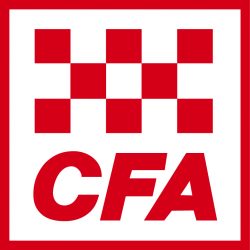In 1971 the fleet was expanded with acquisition of a Dodge panel van to fill a long-standing need for a mobile control point, and for the transport of personnel and specialised equipment. This vehicle was to be replaced with a later model of the same make in February 1977.
Following the precedent set in 1944, the Brigade revived the concept of a junior organisation and in January 1971 established the Junior Reserve. During the years in which it flourished, the Junior Reserve attracted some enthusiastic young members, many of who advanced to the Brigade as firefighters.
Having completed a second term of nine years as Captain, Ray Parker tendered his resignation from office and in July 1971 handed over the leadership to his successor, Lieutenant Frank Stephenson. Frank had enrolled with the Brigade in June 1959, was elected to office as Foreman in 1961, and was promoted as Lieutenant eleven months later.
In 1972 the Brigade’s fire-fighting capabilities were upgraded with the replacement of the pumper with a later model International, equipped with a 650 gpm front mounted pump.
As early as 1971 the Brigade had acknowledged a problem with over crowding, and had agreed in principle to erect “a building on the property for he purpose of providing facilities for meetings and training, for garage accommodation, and for larger kitchen facilities”. The concept was revived in March 1974, and discussions about the proposal with the Authority and a great deal of planning work ensued.
Work commenced on site in February 1975, with the demolition of the old original fire station, which had been used as a store shed. Construction proceeded at a steady rate, the skilled tasks being performed by qualified Brigade members, or by sub-contractors, while the members generally carried out the labouring work. A new hose tower was erected as part o the project.
The building was financed mainly by public donations, raised by Brigade members in door knock appeals, together with contributions from the Authority and the City of Knox. The Ladies’ Committee and the Social Committee were engaged in many fundraising activities to finance the fittings and amenities provided for the Brigade members. The many individuals, firms and organisations that became involved in the work made numerous contributions in the form of services, materials, equipment and machinery to the project.
This quite ambitious project culminated in the official opening f the services building on 9th July 1977 by the Deputy Chairman of the Authority, Mr S. C. Diffey in the presence of a representative gathering, Ex-Captain Ray Parker, upon leaving the district, tendered his resignation in 1978. The Brigade arranged a testimonial dinner in September of that year to recognise their contribution, As the surviving foundation member, Ray had given the Brigade almost 36 years distinguished service, which the Country Fire Authority recognised by creating him Honorary Life Member.
December 1978 saw the replacement of the Dodge van with a Holden V8 station wagon which, equipped with hydrant and hose, was to perform the same multiple role of reconnaissance, operational control and personnel transport.
At this time the prospects of using electronic pagers to complement the fire alarm systems were being considered, the concept having been pioneered in this State by the Bayswater Brigade. The initial order was placed by the Brigade for eleven paging devices in September 1978, and these were soon to be supplemented by further units made available through the financial grant the Group received from the City of Knox.
